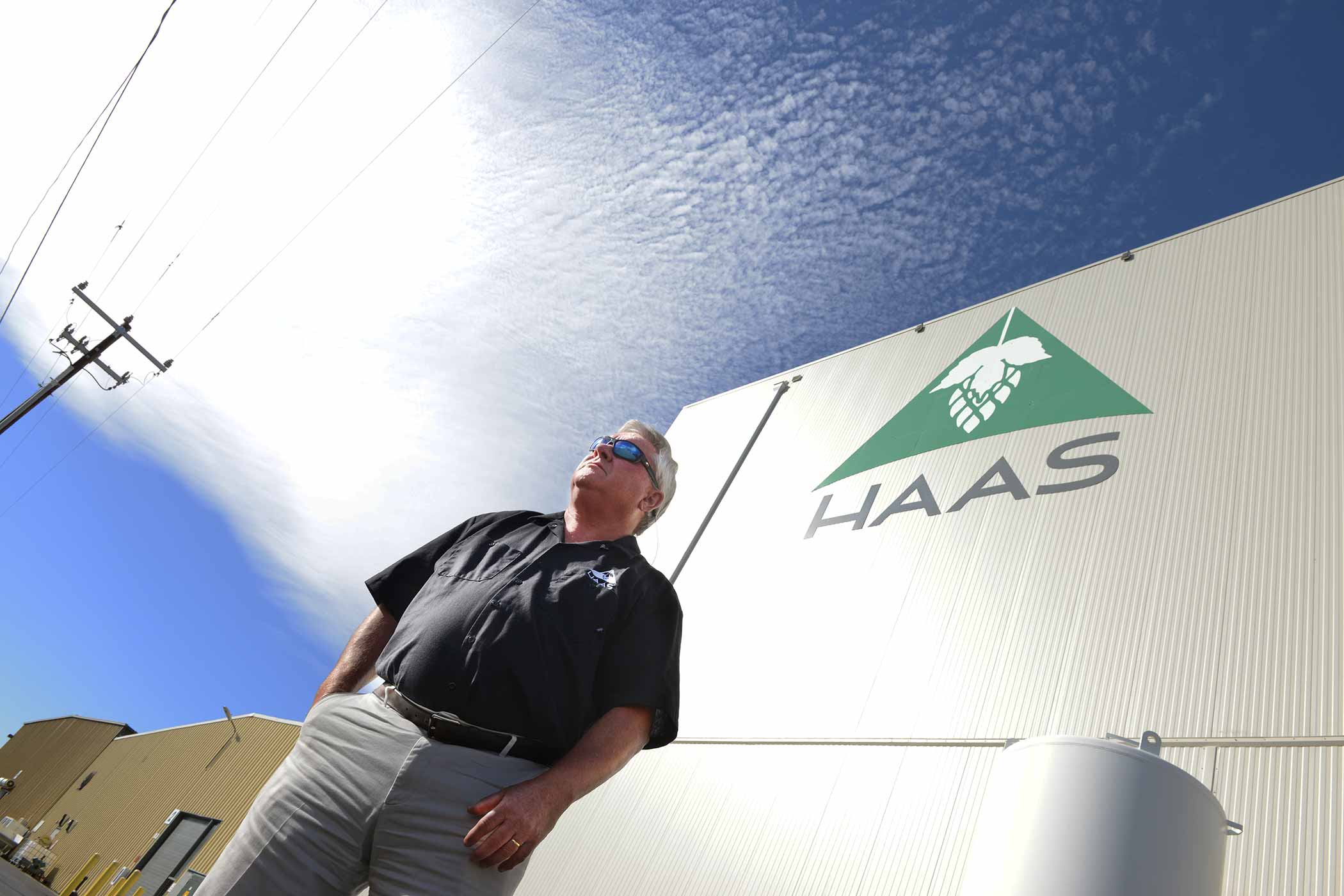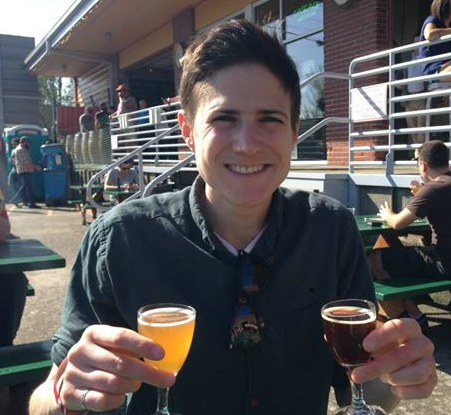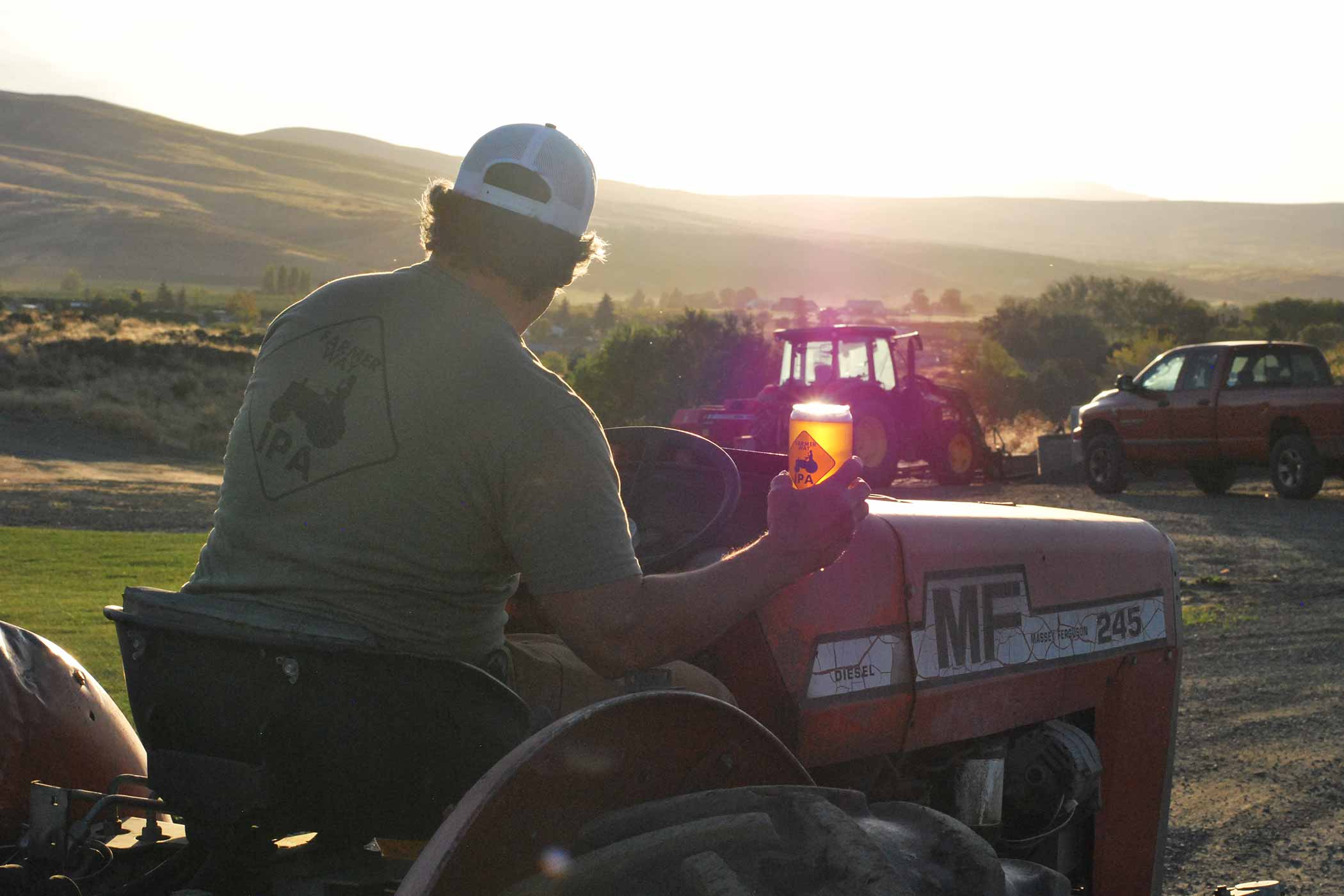Shop
The Hop Whisperer: Meet HAAS’ Brice Hiatt
Shhhhops.
Like This? Read That
A 45-year veteran.
One revolutionary new pelletizing line, called Line 3.
And 659 million pounds of hops of hops pelletized at North America’s leading hops supplier.
HAAS Director of Pellet Operations Brice Hiatt, who is retiring this year, has racked up quite a number of accolades over the years. Walk through the hallowed, cavernous halls of HAAS, and you may hear two little words murmured: Hop Whisperer.
Those who have worked with or know Hiatt have given him an epithet worthy of someone who has dedicated their life to one thing: hops.
But sitting in Hiatt’s office, you’ll never hear him say those words. Hiatt speaks slowly, pausing often to consider his choice of words. His silver hair, in an almost military crew cut, ruddy complexion, and simple black HAAS button-up, belie years spent perfecting the pellet.
He could spend hours rattling on about the right die setting for Citra, hammermills, and blending different alpha levels. But ask him to speak about himself, and he sheepishly tries to steer the conversation back to what he knows best—hops.
“He’s so humble,” says HAAS Marketing Operations Manager Corrie Van Oostrum. “He won’t brag about himself.”
However, he doesn’t need to; his work and history at HAAS speak for themselves.
“I grew up on an orchard,” shares Hiatt, whose dad raised Red Delicious and Golden Delicious apples along with pears.
After graduating from high school in 1979, Hiatt took a part-time job at HAAS. At eighteen years old, he was the youngest person at the company.
You could say Hiatt’s career started with a bang. Several months after joining HAAS, in May 1980, Mount St. Helens erupted. “One of my first big jobs was helping clean up,” says Hiatt. “That was an interesting start to my hop career.”
What started as a part-time job in the warehouse turned into a sixteen-year gig managing all of the shipping and receiving of HAAS’ hop pellets.
When Hiatt’s boss retired in 1996, he recommended that Hiatt take over as plant manager.
“Are you sure about that?” Hiatt says he asked him, admitting he skipped a couple of steps.
“It was pretty scary, but it was,” Hiatt takes a moment to search for the right word, “flattering; it was an honor.”
For the next two-plus decades, Hiatt ran HAAS’ plant, eventually moving up to director of operations.
During that time, Hiatt’s unwavering commitment to producing the best possible pellet for his partners earned him a place in the pantheon of pelletizers.
If the walls of HAAS could whisper, they might tell you about the time Hiatt negotiated with Anheuser-Busch InBev (just Anheuser-Busch at the time) to secure a contract to pelletize the “lion’s share” of their ten million pounds of hops.
Or about the entirely new state-of-the-art pelletizing line he helped implement and design that has revolutionized HAAS’ operations.
They might mumble about how Bell’s, the world’s largest buyer of Centennial hops, turned to Hiatt to blend their crop for the last decade.
Underneath all the stories and accolades, you’ll undoubtedly hear one phrase uttered over and over again.
In the land of hop processing, Hiatt is the undisputed Hop Whisperer.
This is why.
If Consistency Is Key, Hiatt Is King
Ten years ago, John Mallet, then VP of operations at Bell’s Brewery, met Hiatt during a walk-through at HAAS. At the time, Bell’s had become the world’s largest user of one particular hop, Centennial, eclipsing a double-digit percentage of the world supply.
To feed their Centennial needs, Bell’s purchased a large quantity of hops from various vendors.
But that left them with a problem.
“An apple is not just an apple,” explains Mallett, noting that Centennial could change a lot based on a number of variables. “But we were interested in getting all the apples to be the same.”
How do you do that, he posited? By blending them together.
Interested in learning more about HAAS’ pelleting capabilities, Mallet met Hiatt for a tour of the facility.
“I wouldn’t say it was an audit,” laughs Mallett, “but I also wouldn’t say it wasn’t an audit.”
Mallett wanted to assess not only HAAS’ potential but also their people. He believed you could learn a lot just from a company’s environment. As he walked around, Mallett watched how Hiatt interacted with his team. “He struck a chord,” says Mallett. “I wanted to know more.”
What stuck out most to Mallett wasn’t just that Hiatt “had a deep subject matter expertise” and an “encyclopedia knowledge” of hops, but how he communicated that information.
“He listened,” Mallett says simply. “It was the best of both worlds.”
For the last decade, HAAS has worked with Bell’s, blending hops to create stable building blocks for a specific flavor profile that the brewery needs. Year after year after year, Bell’s relied on HAAS. On Hiatt, really, and his team to deliver.
“One thing we hear a lot from our customers is how consistent the pellets are,” says Van Oostrum. “It becomes so valuable to have a high-quality agricultural product that stays consistent and true year over year.”
Hiatt chimes in with a recent example of processing half a million pounds of Centennial for a customer. The hops came into HAAS with alpha levels ranging from 9% to 13.5%, but through blending, Hiatt and his team created a homogenized pellet with an 11% alpha level. “Every box [of hops] they use at the brewery will give them the same consistency and quality,” he beams.
For Bell’s, preserving the integrity of those raw materials is paramount. “I always said that the beer should be like a piece of glass,” says Mallett. “You should be able to look through the beer to see the field where the barley and hops came from.”
Turning hops from leaves into pellets, says Mallett, without affecting their inherent qualities is very tricky. “You can inadvertently f**k it up,” Mallet points out. “And Hiatt never f**ked it up.”
With Hiatt, It’s Not Just a Roll of the Die
You might not know it by looking at him, but much like a football player excels at ballet, the “big dude,” as Mallett calls him, has a delicate touch with hops.
“We tend to make a softer pellet than everybody else,” explains Hiatt.
His secret? It’s not so much a secret as it is an attention to detail. Think of hops like people—every variety is different, and each has different needs. Not every hop variety should be processed in the same way. One might call hop pelletizing a spectrum.
Technically, Hiatt says, based on attributes like the density of a specific crop, they use different dies in the machines to process varieties differently.
He gives an example. “A Millennium at fifteen percent versus a Zeus at fifteen percent makes a totally different pellet, so you have to run your equipment differently,” Hiatt notes. “Millennium has a less dense core, so it grinds up differently, meaning you have to use a different die.”
Hiatt patiently explains this to us—people who have never operated a machine in a pelletizing plant before—pausing to ensure we understand.
You can tell he wants to say more to go deeper into the details, but instead, he almost mumbles that this is just one example of the experience you gain over the years in the job. “You’ve got to be ready to make those changes,” he emphasizes.
It’s a feel, a touch, that Hiatt’s gained. Despite driving a lot of the automotive innovation at HAAS over the years, Hiatt still has that almost old-school touch.
He just knows.
Much like a secret sauce or seasoning, Hiatt wouldn’t divulge everything, but he adds that “We’re looking at the whole picture,” considering not just the alpha content and density of a hop but where it came from as well.
“It’s not just the alpha that I was looking at. We were looking at where they’re grown, the grower, all of that,” he notes. “Let’s say you have forty-nine lots and seven of them were from Oregon. Well, we wouldn’t run all seven Oregon lots in one. We would put one Oregon lot in each blend. You see what I mean?”
We do. We see that Hiatt takes each HAAS customer seriously, tailoring their approach to their specific requests through a honed sense of science and expertise.
Every year is unique, and each blend is distinct. “You have to pay attention,” says Hiatt, who has been known to call the lab at two in the morning to make sure a particular crop of pellets they’re processing is on track. “What I’m trying to say is that our quality is being looked at 24/5” (the lab shuts down on the weekend for maintenance).
The devil is in the details, and Hiatt is a fiend for perfection.
Becoming a Hop Whisperer
We won’t say that turning a hop into a pellet is like turning water into wine, but we might say that it’s like turning a bine into beer.
Pelletizing hops isn’t simple.
When Hiatt first started working at HAAS, and even at the turn of the century, the team did everything by hand.
“Everything,” says Hiatt. “The filling of the foil, the stacking of cartons, everything was manual.”
But in 2004, a big dog came barking. According to Hiatt, AB InBev (then known as Anheuser-Busch) considered switching from whole-cone to T-90 pellets—approximately nine to fourteen million pounds of pellets.
Hiatt, who was part of the negotiating teams, says that was “the trigger” for HAAS to automate the plant more.
The forty-five-year veteran considers landing AB InBev as one of his most significant accomplishments at the company.
As Hiatt tells it, when AB InBev came to town to negotiate, they considered HAAS their third choice. After HAAS did some trials for the macrobrewery, the company’s group director of brewing raw materials said, “The proof will be in the pellets,” recalls Hiatt.
At the end of the trials, as the group stood around drinking some Budweisers, Hiatt says he turned to the group director and said, “I’ve been waiting ten years for you to give me your hops to fix them.”
“He has never forgotten that,” Hiatt continues with a grin. “Every time I see him, he brings that up because he says I had him at that line.”
Hiatt secured the contract, pelletizing six million of AB InBev’s hops that first year.
Other big breweries came calling—Red Hook, Widmer. “They called themselves the ‘Class of 88,’” says Hiatt. “They were the leaders of the microbrewing industry, so we worked hand-in-hand with them to get them up and running.”
New Belgium, too, came to Hiatt for advice. “They were having some trouble with Cascade pellets that were too hard,” says Hiatt, who gave them some suggestions on how to fix the issue. No surprise here, he said they had a density problem, running the wrong die.
When your pellets are too dense, they’ll sink to the bottom of the boil kettle without dissolving. “They’re still just pellets,” says Van Oostrum. “Brice’s pellets just dissolve. They do what they’re supposed to do.”
“[After that], I believe they trusted me quite a bit,” shares Hiatt.
You can see how, over the years, Hiatt’s reputation has earned him the nickname Hop Whisperer.
It’s a title he shyly shirks, preferring to point out that he’s been fortunate to have such a great team that works with him to “keep me out of trouble.” But whether he likes it or not, this is how some of the most prominent players in the game, from AB InBev to New Belgium to Bell’s, think of him.
When I ask Mallett to describe Hiatt in just a few words, he answers without hesitation: “attentive, deeply competent, knowledgeable, respectful.”
Hiatt is the Hop Whisperer. And his legacy will live on at HAAS.
The Legacy of Line Three
In May 2022, HAAS broke ground on a new pelletizing line, their third. Taking his years of experience working with lines one and two, Hiatt designed line three to be state-of-the-art.
Efficient, powerful, streamlined, line three can process 150,000 pounds of hops per day during the harvest. That’s more than lines one and two combined, which average 130,000 pounds per day.
“Line three gave us the opportunity to spread out and design the equipment to flow more fluidly and efficiently,” explains Hiatt, who described the construction like “building a ship in a bottle.” All the equipment and tanks had to be brought in through a large opening on the back wall.
“We almost tripled our capacity by adding line three,” Hiatt shares proudly, who also notes that the third line has helped HAAS process the entire harvest much faster. “We used to start in September and be done in May, but now we’ll be done in March every year.”
This past harvest may have been Hiatt’s last at HAAS.
This year, Hiatt will officially retire. “My favorite Seahawks player is Steve Largent,” he admits with a laugh. “I’m old.”
And while he may no longer be prowling the plant or calling the lab at two in the morning, his legacy will live on in HAAS’ pellets, in their partners’ beers.
Much like any tactician or artisan, Hiatt has his tricks of the trade. “It’s not like making pellets is a huge secret,” he says matter-of-factly, “but there are certain things we do that I think are important that others aren’t doing.”
That’s about as “brash” a statement as you’re going to get from the soft-spoken savant.
Hop Whisperer may be a name Hiatt brushes to the side with a blush, but you can bet that long after he leaves, when you walk through line three, those hallowed HAAS halls, you’ll hear his name whispered. And the hops, they’re listening. That’s all that matters.




